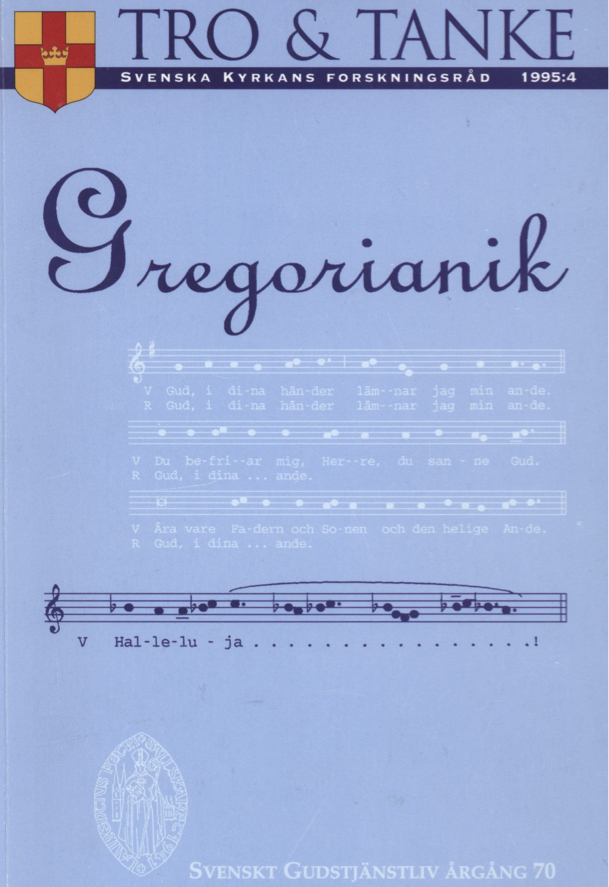Gregoriansk uppförandepraxis: några problem, några lösningar
Abstract
The desire to find the right manner of performance arose at the same time as the revival of the Gregorian chant in the 19th century: the melodies were to be restored to their original form, and surely also the performance style; Solesmes did both these things.
In our century, the Plainchant has come out of the exclusively ecclesiastical sphere, and the question is: is it possible to find criteria for an authentic performance in the same sense as for other ”early music”, from Ockeghem to Mozart?
Two peculiarities distinguish the Plainchant from other early music: 1) The difficulty of giving an exact definition: it flourished all over Europe for a thousand years, with all the natural modifications of old monophonic music - and the performance must have varied, too. 2) The small amount of historical evidence: the documents speaking of the performance are sparse, obscure, or of mere technical interest. No liturgical community could boast an unbroken tradition, not even from the last 500 years. The earliest chant notation is much later than the melodies. Etcetera.
As to the Solesmes school, the rule of equavdism cannot, in my opinion, be proved by historical arguments; the two- och three-note groups and the concomitant system of the ictus is, similarity, a result of mere speculation. But some negative postulates of the Solesmes school can be agreed with, such as the liberation from the slow, chorale-like singing of the previous centuries, and the stylized singing which expels exaggerated effects and too direct ways of expression.
The semiological school, based on some 10th—11th century codices equipped with a set of nuance-rich neume varieties, seeks to reconstruct the original forms of the chant. The practical rule system has two weak points: its complicated system of note values which is, too, a modem product of speculation and the fact that its basic codices are, after all, produced only by some rather scolastic and over-theorized communities, within a short period. If there is any one firm point in the history of chant performance, it is that it should be different according to periods, regions, genres, traditions, situations, etc. The semiologists’ most important contribution is that the sources stimulate to the sensitive play of well differentiated length of notes, and their applicating of the celeriter marks which has led to a more fluent and vivid singing.
Other suggestions of performance may be sought for in other monophonic cultures, e.g., folk music, other old liturgies - not as direct models, but as a fine musical background for the singer. Also the variants of Plainchant melodies each us to adhere to the row of main notes and to string on to it the formulas and the subordinated details.
After all, the main director of the performance remains the score itself, and this musical order gives much more unmistakable information for a good musician than the most detailed set of marks. The notation of the Gregorian music offers two sure points of departure: the grammar of the text, which gives us the greater traits, and the skeleton notes within those units.
Three addenda: 1) The possibility that the notes in one and the same figure may be interpreted or membered in various ways. If the fundamental logic of the tonality is not violated, this kind of difference can be tolerated. 2) We can realize the musical essence in the actual performance with the musical time as our most important tool - the performance depends not on rhythm but on agogics. 3) On the level of details, the phonetic characteristics of the text modify the performance of similar motifs, either helping or counterbalancing.
After all, we may attempt to give some elastic rules for chant performance. 1) The more important of these are the negative indications. There is no trace in chant of any trend to illustrate the meaning of the words! This is a ”family trait”, common with old folk music, e.g., and this tradition also prohibits sharp contrasts; the rich store of voice production means must not transcend the frame. The best solution, I think, is to keep a vigorous mezzoforte during the whole piece and to follow the change of main and auxiliary notes by changing the weight of the voice rather than the dynamics.
2) Some positive advice: the main law is to tolerate the multiformity within the borders of the style - which is not to be equated with an arbitrary performance.
We may speak of a musical and a functional authenticity of the performance.
The functional authenticity is the harmony between the chant and the outside world: the context requires different attitudes, tempi, amount of nuances. The tradition of the singing group, its musical background, and the everyday life of the 20th century find their place in the Gregorian chant itself, just because it is a basical musical idiom.
The musical authenticity can allow few or many nuances, if only the sounds are clear and understandable, and the inner logic of the text remains unviolated. This kind of authenticity does not differ from that of any music, and consists of the balance of clear shapes, of homogeneity and richness of details.
Downloads
Publicerad
Nummer
Sektion
Licens
© författarna, Laurentius Petri Sällskapet för svenskt gudstjänstliv samt Artos & Norma bokförlag. Det är tillåtet att kopiera och använda material ur Svenskt Gudstjänstliv för forskningsändamål om källan anges. För övriga ändamål kontakta respektive artikelförfattare samt förlaget. Särskilda restriktioner kan gälla för bildmaterial.


